 Technology peripherals
Technology peripherals
 AI
AI
 Autonomous driving 'going to the cloud' has become a general trend, and research and development 'going to the cloud' is the key
Autonomous driving 'going to the cloud' has become a general trend, and research and development 'going to the cloud' is the key
Autonomous driving 'going to the cloud' has become a general trend, and research and development 'going to the cloud' is the key
The "cloud" of autonomous driving data has become a general trend, so what is the next step? At present, the autonomous driving industry has entered the second half of commercial implementation, and there are more and more vehicles equipped with various levels of autonomous driving systems on the road. For car companies, on-the-ground delivery is not only a recognition of their years of painstaking research and development, but also faces the challenge of the huge amount of data brought about by mass production. At present, it is obviously not cost-effective to just build a new computer room, and data storage "is on the rise" Cloud" has become the best choice.
But as the autonomous driving industry becomes more and more "volumey", car companies' demand for cloud is no longer satisfied with just data storage itself, such as perception model training, simulation testing, research and development The demand for smart car clouds such as tool chains is also growing. Therefore, at this time point, the "cloud" of autonomous driving data can be regarded as the minimum requirement, and the "cloud" of autonomous driving research and development is the key. So, what is the biggest demand for cloud among car companies right now? How can cloud services assist autonomous driving development? Where will the smart car cloud develop in the future?
Recently, Ernst & Young (China) Business Consulting Co., Ltd. (hereinafter referred to as "EY") and Huawei Smart Car Solutions BU jointly wrote and released "From "Cloud" to "Enter" "Cloud", cloud services empower the intelligent network upgrade of the automotive industry - Smart Car Cloud Service White Paper (hereinafter referred to as the "White Paper").
This "White Paper" is also the first white paper on the application of cloud services in the era of smart cars in the automotive industry and its core business applications. The book provides a detailed explanation of the current application scenarios of smart car cloud services such as autonomous driving development and Internet of Vehicles. In this regard, Che Dongxi found the answer to the above question from this "White Paper".
01.“Moving data to the cloud” for autonomous driving is only the first step
If the development of the autonomous driving industry is divided into two halves, then the first half is the development and verification stage from zero to one, while the second half is the commercial implementation stage from one to many.
In the first half of the competition, car companies competed to see whose autonomous driving system algorithm was more efficient and whose takeover rate was lower. In the second half, the competition is about who has the largest delivery scale and the most actual mileage. After all, practice is the only criterion for testing truth, and the same applies to autonomous driving.
Nowadays, there are more and more self-driving vehicles at all levels, the scope of driving tests is getting wider and wider, and the application scenarios are becoming more and more abundant. For car companies, "more cars and more roads" is certainly a good thing, but the massive amount of data that comes with it has become a new "headache." Generally speaking, in the autonomous driving research and development stage, if there are 10 test vehicles and the cumulative number of collection days is 300 days per year, a single vehicle can generate about 10TB of data every day, and the total amount of data generated annually reaches about 30PB. In the commercial implementation stage, although the vehicles will not run day and night like the test vehicles, the total number of vehicles will increase exponentially.
If we estimate based on 100,000 vehicles and 300 cumulative collection days per year, the total amount of data faced by car companies in the future will reach ZB level. Here is a brief introduction to the conversion relationship between PB level and ZB level. 1ZB=1024EB, 1EB=1024PB. Using the familiar TB unit to convert, 1ZB is approximately equal to 1 billion TB. The data pressure faced by car companies can be imagined.
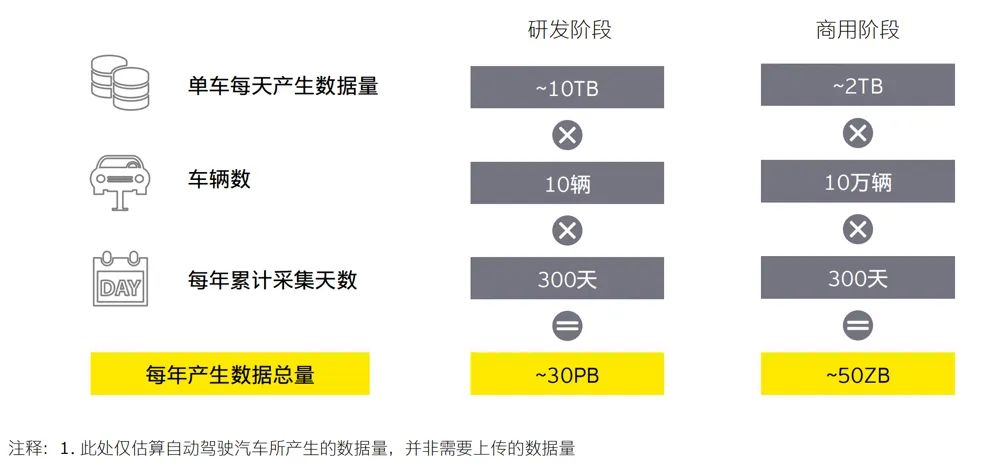
##▲The amount of data in the commercial stage will reach ZB level (picture taken from the white paper text)
At this stage, whether it is in terms of construction, operation and maintenance costs or information security, it is obvious that building or expanding computer rooms cannot keep up with the speed of data growth.
"Traditional data centers can no longer adapt to the requirements of commercialization of autonomous driving. "Moving to the cloud" is the only way for autonomous driving to move from development to commercialization." A high-tech company's intelligence Said the general manager of Cheyun Service Product Department.
It can be seen that in the second half of the commercialization of autonomous driving, data "cloud" has become a major need for car companies and will also determine whether it can be realized. An important factor in rapid iteration.
#However, massive data not only brings storage problems, but also how to efficiently utilize and process it is another big problem.
Therefore, "moving data to the cloud" is only the first step, and the significance of the smart car cloud for autonomous driving is by no means just to satisfy the data storage itself.
02.How to train the perception model. Data annotation "into the cloud" is the key
As mentioned above, automatic The driving industry is in the second half of commercial implementation. On the surface, each company is striving for implementation, scale, and mileage, but behind the scenes, what they are actually striving for is the ability to quickly iterate and solve corner cases.
#In other words, the commercialization of autonomous vehicles cannot be separated from continuous and efficient algorithm iteration.
For the iteration of autonomous driving algorithms, perception model training and simulation testing are top priorities. The former is directly related to the safety of the autonomous driving system, while the latter determines Whether the autonomous driving system can achieve rapid iteration.
However, according to feedback from R&D personnel of some car companies, perception model training and simulation testing are also two major pain points in the entire autonomous driving research and development process.
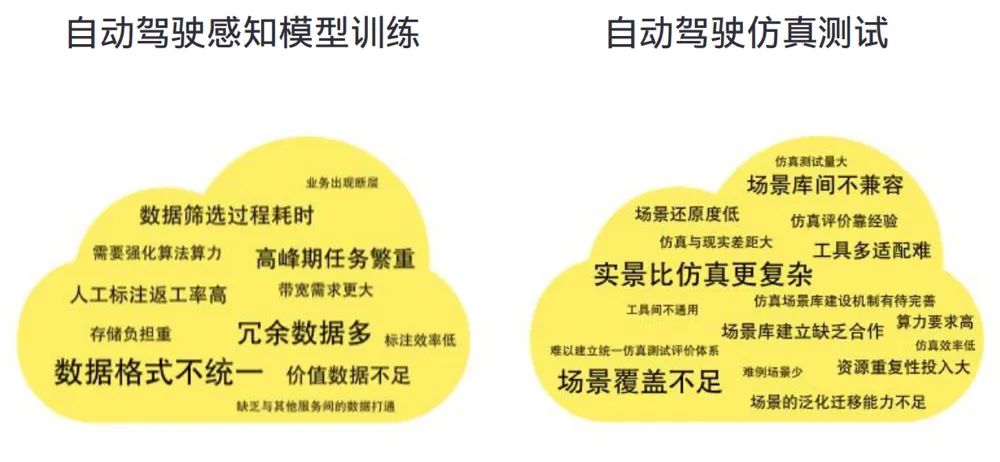
##▲ High-frequency pain point scenarios related to autonomous driving (pictures taken from the white paper text)
The first is perception model training. As we all know, autonomous driving systems are similar to human drivers in terms of perception. They sense the external environment through various sensors. The former relies on cameras, lidar, and millimeter-wave radar, while human drivers rely on their eyes, ears, and even noses. Moreover, for both autonomous driving systems and human drivers, it is relatively easy to see, but more difficult to identify.
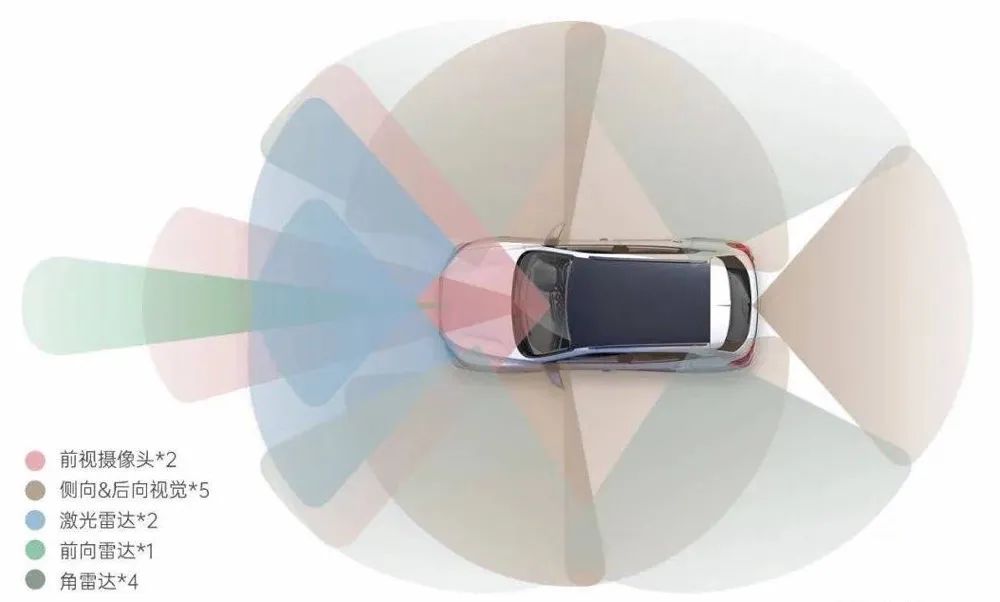
▲Autonomous driving perception solution
Therefore, perception model training is It becomes the most basic and important part of the autonomous driving research and development process. After all, only when you see clearly and recognize what it is can you plan and make decisions. Specifically, perceptual model training can be divided into five major links according to the process, namely data storage, data preprocessing, difficult example mining, data annotation, and model training.
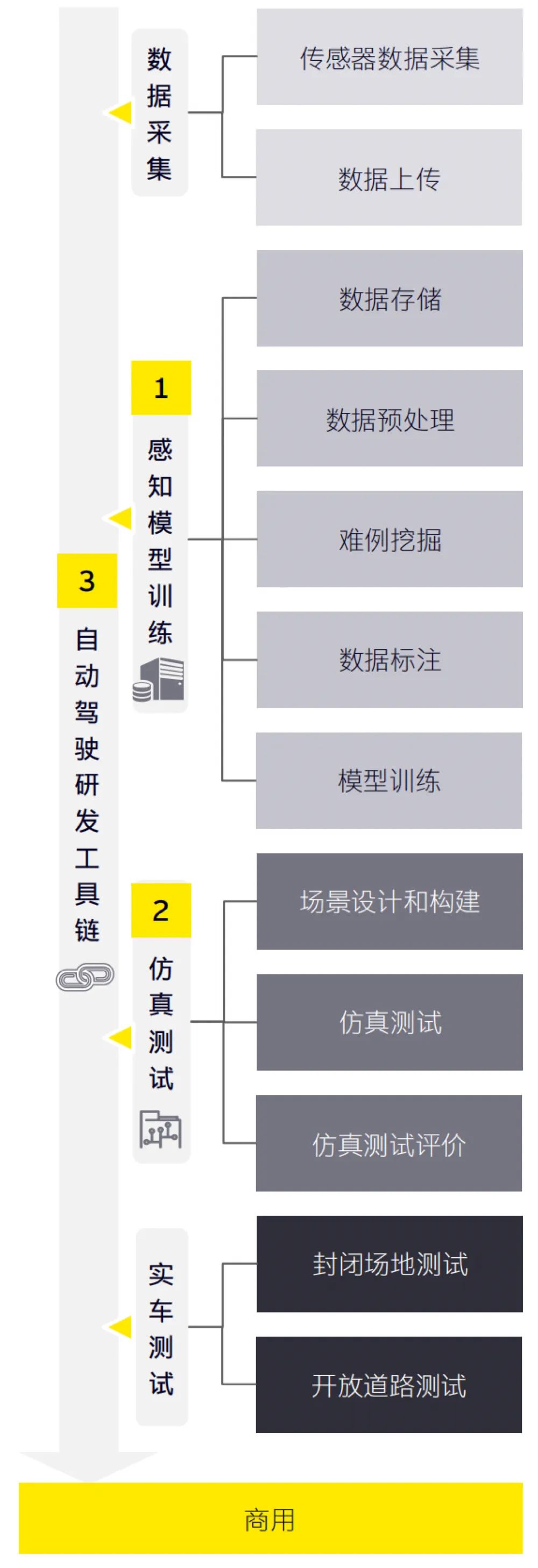
##▲Key control points for autonomous driving research and development (picture taken from the white paper text)
Among these five major links, data annotation is the most time-consuming and labor-intensive one, causing many car companies to call it a "headache." Data annotation refers to target detection and recognition of various types of information such as images, videos, and road sign text captured by sensors through artificial and intelligent tools. To put it simply, data annotation is to mark out the information in the image (point cloud, camera) one by one. It is a simple task that requires extremely high accuracy and efficiency.
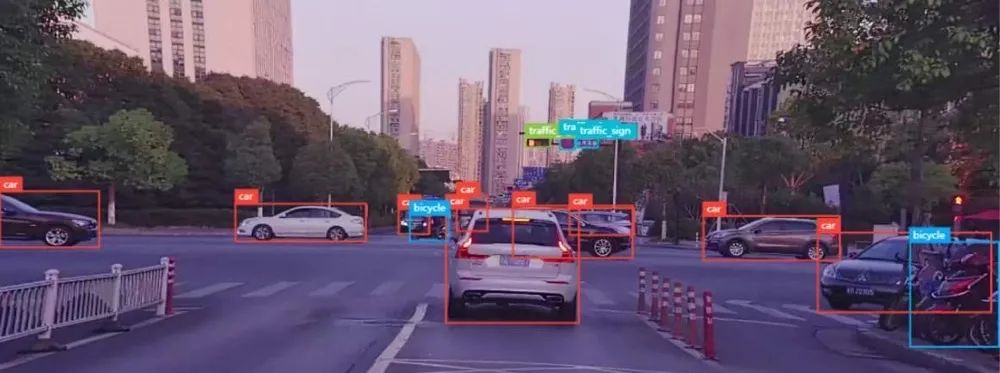
So, when humans are processing this When working, problems such as time-consuming data screening, high rework rate of manual annotation, and inconsistent data formats will inevitably occur, which makes the overall annotation efficiency relatively low. A foreign self-driving car company also reduced the proportion of manual labeling in order to improve the efficiency of data labeling. Since manual efficiency is low, what about using AI for data annotation? Although labeling data through AI solves the problem of manual efficiency, the depth and breadth of data accumulation will directly limit and affect the learning ability of AI, and the computing power of the basic algorithm model cannot bear the increasing amount of data.
Therefore, for tasks such as autonomous driving perception models that require large amounts of training data, high algorithm accuracy, and fast training efficiency, it is more suitable to use automotive cloud services. data processing.
Compared with the data processing capabilities of manual and local AI training, automotive cloud services can effectively ease autonomous driving with the advantages of super computing power, efficient and accurate intelligent strategies Various problems and challenges that arise during data processing.
The "White Paper" mentioned that the commercial implementation of high-level autonomous driving in closed scenes such as ports and mines is earlier than that of passenger cars, and automotive cloud services will also play a "brain on the cloud" in these industry application scenarios. ” of great value. Taking driverless driving in mining areas as an example, automotive cloud services play a crucial role in the training of perception models.
Unmanned trucks often encounter unstructured roads, random rockfalls, special-shaped vehicles, etc. in mining areas, and there are also harsh environments such as flying dust and blown soil in mining areas. For the development of autonomous driving systems, this is a great test of the accuracy of data annotation and the efficiency of model training. Automotive cloud services can quickly help autonomous driving through efficient data processing, difficult case mining, automatic annotation, model training and other capabilities. The truck adapts to the complex operating environment in the mining area, reduces the takeover rate, and improves the efficiency of unmanned operations.
In terms of data, the efficiency of local AI training data processing is 3 to 4 times higher than that of manual processing. Relying on the higher computing power and more accumulated experience of the cloud, The comprehensive processing efficiency of automotive cloud service data processing is increased by more than 10 times, and data processing costs are reduced by 50% compared with manual labor.

##▲The development history of data processing for autonomous driving research and development (picture taken from the white paper text)
In summary, in terms of data processing for autonomous driving R&D, the advantages of automotive cloud services are gradually becoming more prominent. Not only can it effectively identify high-value data, optimize storage space, and accelerate difficult case mining, it can also use deep learning to improve automatic labeling capabilities, optimize the efficiency and accuracy of labeling algorithms, and reduce data processing costs.
03.If you want to quickly iterate simulation testing, you need the cloud to help
After solving the data processing problem, for car companies that continue to invest in autonomous driving, massive testing is indispensable if they want to achieve rapid iteration. The general view in the industry is that the autonomous driving system requires at least 10 billion miles (approximately 16.1 billion kilometers) of test drive data to ensure the safety of the vehicle on the road. However, it is obviously difficult to complete the test vehicle alone by running "day and night".
# Therefore, simulation testing has become an important part of autonomous driving research and development, and it is also the only way to go. According to statistics, during simulation testing, car companies mainly face four major challenges, namely insufficient scene library coverage and incompatible formats between industries; simulation testing involves a large mileage, many scene categories and is time-consuming; simulation The deviation between the test and the actual vehicle road test is large and the confidence level is low; the simulation evaluation system is imperfect and the feedback effect is poor.

##▲Autonomous driving simulation test system (picture taken from the white paper text)
Moreover, simulation testing requires a high level of technical team capabilities, and requires a variety of cross-disciplinary professional skills. It also requires a higher level of business integration, far exceeding other business links in autonomous driving research and development. The above challenges and problems have also triggered the urgent need to "enter the cloud" for simulation testing. So what problems can the simulation car cloud solve? How to solve the problem?First of all, the simulation car cloud service helps the simulation scene library become more standard and comprehensive by building an open scene library. Secondly, relying on the powerful computing power and high concurrency processing capabilities of large-scale parallel simulation in the cloud, the single-line mode is transformed into a concurrent mode, supporting the completion of multiple simulation tasks in multiple scenarios at the same time, greatly improving simulation efficiency.

As for simulation testing and actual To solve the problem of large vehicle road test deviations, the simulated car cloud service can integrate professional capabilities in multiple fields such as computer software, vehicle power engineering, transportation, etc., to improve the fidelity of simulation tests from micro to macro. Finally, in terms of simulation test evaluation, the automotive cloud service is based on the experience of the automotive industry and combined with the scenario library, which can provide a multi-dimensional and comprehensive evaluation index system for the simulation test process, support customized services of evaluation indicators for different car companies and different development stages, and accelerate Algorithm iteration and scene library optimization for simulation testing.
So in summary, for the entire autonomous driving cloud service, the high-quality simulation test system is like the crown jewel, which most representatively reflects the “cloud” of autonomous driving research and development. the value of. Among the two key control points of autonomous driving research and development, data processing and simulation testing, the role of the smart car cloud cannot be underestimated. For car companies involved in autonomous driving, the importance of the smart car cloud is now as important as sensors, computing platforms, and vehicle manufacturing, and has become a secret weapon to reduce costs and increase efficiency in the second half of commercial implementation.
##04.How to improve R&D efficiency and tool chain integration is the key
When the efficiency of perception model training and simulation testing is improved, does it mean that the efficiency of the entire autonomous driving research and development process can be improved as a whole? the answer is negative.
For example, during the autonomous driving research and development process, a certain car company had to develop model iterations due to the scattered tools used at different stages and different data processing formats. 2 months, inefficient and costly.
This also means that only improving the efficiency of a single R&D process without a complete autonomous driving R&D tool chain cannot effectively improve the overall R&D efficiency. The final result is likely to be 1 1 Therefore, for car companies, a full-stack end-to-end autonomous driving research and development tool chain is crucial.
The senior director of an automotive technology center said that traditional car companies need to move from the original waterfall-style system integration development model of the car end to the agile approach of cloud-pipe-end integration. Transformation of scenario integrated development model. Coincidentally, in terms of underlying processing capabilities, cloud services make it easier to help the autonomous driving R&D tool chain achieve a data closed loop and build a set of automated development tool chains covering data collection, storage, processing, annotation, model training, simulation, and evaluation. . For car companies, when they have a research and development tool chain supported by the smart car cloud, they can open up the "end-to-end" development process throughout the chain, significantly reduce development costs, and improve system iteration and operation and maintenance efficiency.
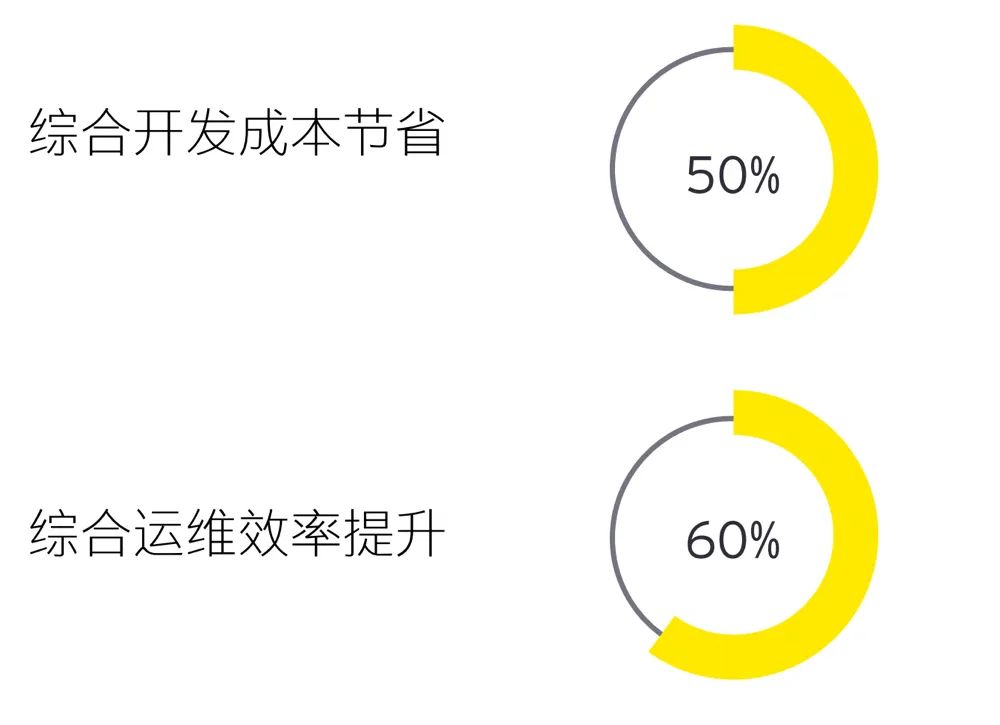
▲The "end-to-end" tool chain empowers the autonomous driving research and development process to reduce costs and increase efficiency (picture taken from the white paper text)
From the data point of view, this "end-to-end" autonomous driving R&D tool chain can help car companies save 50% of comprehensive development costs and improve comprehensive operations by 60%. Dimensional efficiency.
05.Conclusion: Car companies and cloud service providers are rushing in both directions
So , in addition to showing its talents in the research and development of autonomous driving, what other application scenarios do smart car cloud services have? In fact, in addition to the three major scenarios mentioned above, smart car cloud services have quietly been launched throughout the vehicle life cycle. Currently, there are 9 new scenarios for automotive cloud services throughout the vehicle life cycle, as well as 21 specific application scenarios in more detailed dimensions, including research and development, sales, use, after-sales services, and other derivative services.
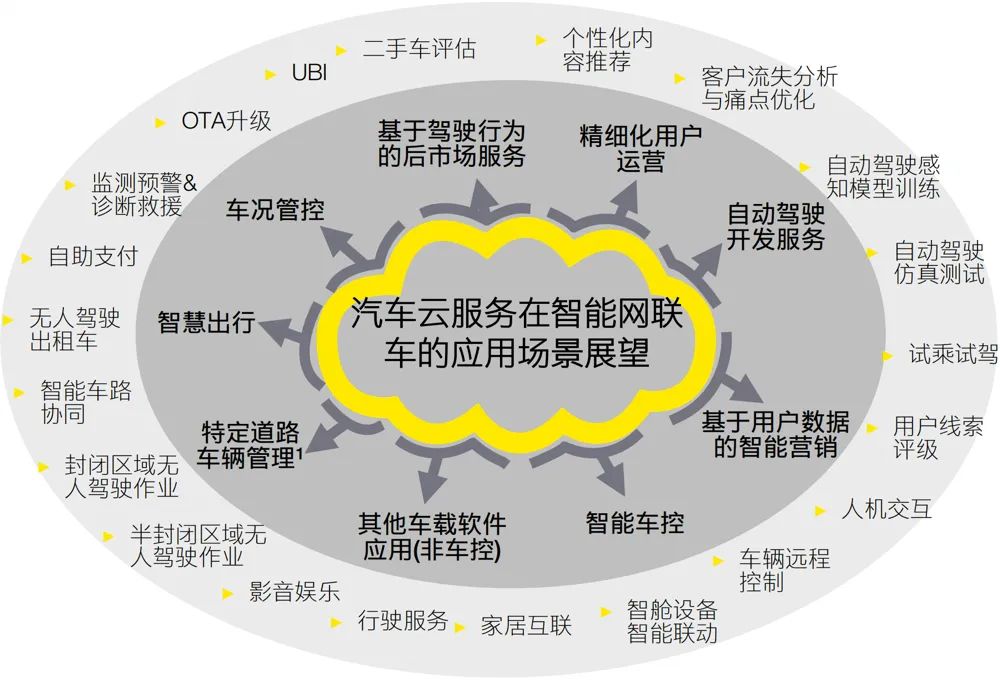
##▲Prospects for application scenarios of automotive cloud services in intelligent connected vehicles (picture taken from the white paper text)
In short, the smart car cloud has become an indispensable part of the smart connected car industry. It is helping data to maximize its value in business applications, and is helping car companies in the process from research and development to commercial use. Reduce costs and increase efficiency. Car companies are also making strides with cloud manufacturers towards the deep end of business-level cooperation, gradually forming a good situation of two-way empowerment, and working hand in hand on the road to upgrading intelligent network connectivity.The above is the detailed content of Autonomous driving 'going to the cloud' has become a general trend, and research and development 'going to the cloud' is the key. For more information, please follow other related articles on the PHP Chinese website!

Hot AI Tools

Undresser.AI Undress
AI-powered app for creating realistic nude photos

AI Clothes Remover
Online AI tool for removing clothes from photos.

Undress AI Tool
Undress images for free

Clothoff.io
AI clothes remover

Video Face Swap
Swap faces in any video effortlessly with our completely free AI face swap tool!

Hot Article

Hot Tools

Notepad++7.3.1
Easy-to-use and free code editor

SublimeText3 Chinese version
Chinese version, very easy to use

Zend Studio 13.0.1
Powerful PHP integrated development environment

Dreamweaver CS6
Visual web development tools

SublimeText3 Mac version
God-level code editing software (SublimeText3)

Hot Topics
 1386
1386
 52
52
 The facial features are flying around, opening the mouth, staring, and raising eyebrows, AI can imitate them perfectly, making it impossible to prevent video scams
Dec 14, 2023 pm 11:30 PM
The facial features are flying around, opening the mouth, staring, and raising eyebrows, AI can imitate them perfectly, making it impossible to prevent video scams
Dec 14, 2023 pm 11:30 PM
With such a powerful AI imitation ability, it is really impossible to prevent it. It is completely impossible to prevent it. Has the development of AI reached this level now? Your front foot makes your facial features fly, and on your back foot, the exact same expression is reproduced. Staring, raising eyebrows, pouting, no matter how exaggerated the expression is, it is all imitated perfectly. Increase the difficulty, raise the eyebrows higher, open the eyes wider, and even the mouth shape is crooked, and the virtual character avatar can perfectly reproduce the expression. When you adjust the parameters on the left, the virtual avatar on the right will also change its movements accordingly to give a close-up of the mouth and eyes. The imitation cannot be said to be exactly the same, but the expression is exactly the same (far right). The research comes from institutions such as the Technical University of Munich, which proposes GaussianAvatars, which
 MotionLM: Language modeling technology for multi-agent motion prediction
Oct 13, 2023 pm 12:09 PM
MotionLM: Language modeling technology for multi-agent motion prediction
Oct 13, 2023 pm 12:09 PM
This article is reprinted with permission from the Autonomous Driving Heart public account. Please contact the source for reprinting. Original title: MotionLM: Multi-Agent Motion Forecasting as Language Modeling Paper link: https://arxiv.org/pdf/2309.16534.pdf Author affiliation: Waymo Conference: ICCV2023 Paper idea: For autonomous vehicle safety planning, reliably predict the future behavior of road agents is crucial. This study represents continuous trajectories as sequences of discrete motion tokens and treats multi-agent motion prediction as a language modeling task. The model we propose, MotionLM, has the following advantages: First
 Do you know that programmers will be in decline in a few years?
Nov 08, 2023 am 11:17 AM
Do you know that programmers will be in decline in a few years?
Nov 08, 2023 am 11:17 AM
"ComputerWorld" magazine once wrote an article saying that "programming will disappear by 1960" because IBM developed a new language FORTRAN, which allows engineers to write the mathematical formulas they need and then submit them. Give the computer a run, so programming ends. A few years later, we heard a new saying: any business person can use business terms to describe their problems and tell the computer what to do. Using this programming language called COBOL, companies no longer need programmers. . Later, it is said that IBM developed a new programming language called RPG that allows employees to fill in forms and generate reports, so most of the company's programming needs can be completed through it.
 GR-1 Fourier Intelligent Universal Humanoid Robot is about to start pre-sale!
Sep 27, 2023 pm 08:41 PM
GR-1 Fourier Intelligent Universal Humanoid Robot is about to start pre-sale!
Sep 27, 2023 pm 08:41 PM
The humanoid robot is 1.65 meters tall, weighs 55 kilograms, and has 44 degrees of freedom in its body. It can walk quickly, avoid obstacles quickly, climb steadily up and down slopes, and resist impact interference. You can now take it home! Fourier Intelligence's universal humanoid robot GR-1 has started pre-sale. Robot Lecture Hall Fourier Intelligence's Fourier GR-1 universal humanoid robot has now opened for pre-sale. GR-1 has a highly bionic trunk configuration and anthropomorphic motion control. The whole body has 44 degrees of freedom. It has the ability to walk, avoid obstacles, cross obstacles, go up and down slopes, resist interference, and adapt to different road surfaces. It is a general artificial intelligence system. Ideal carrier. Official website pre-sale page: www.fftai.cn/order#FourierGR-1# Fourier Intelligence needs to be rewritten.
 Huawei will launch the Xuanji sensing system in the field of smart wearables, which can assess the user's emotional state based on heart rate
Aug 29, 2024 pm 03:30 PM
Huawei will launch the Xuanji sensing system in the field of smart wearables, which can assess the user's emotional state based on heart rate
Aug 29, 2024 pm 03:30 PM
Recently, Huawei announced that it will launch a new smart wearable product equipped with Xuanji sensing system in September, which is expected to be Huawei's latest smart watch. This new product will integrate advanced emotional health monitoring functions. The Xuanji Perception System provides users with a comprehensive health assessment with its six characteristics - accuracy, comprehensiveness, speed, flexibility, openness and scalability. The system uses a super-sensing module and optimizes the multi-channel optical path architecture technology, which greatly improves the monitoring accuracy of basic indicators such as heart rate, blood oxygen and respiration rate. In addition, the Xuanji Sensing System has also expanded the research on emotional states based on heart rate data. It is not limited to physiological indicators, but can also evaluate the user's emotional state and stress level. It supports the monitoring of more than 60 sports health indicators, covering cardiovascular, respiratory, neurological, endocrine,
 What are the effective methods and common Base methods for pedestrian trajectory prediction? Top conference papers sharing!
Oct 17, 2023 am 11:13 AM
What are the effective methods and common Base methods for pedestrian trajectory prediction? Top conference papers sharing!
Oct 17, 2023 am 11:13 AM
Trajectory prediction has been gaining momentum in the past two years, but most of it focuses on the direction of vehicle trajectory prediction. Today, Autonomous Driving Heart will share with you the algorithm for pedestrian trajectory prediction on NeurIPS - SHENet. In restricted scenes, human movement patterns are usually To a certain extent, it conforms to limited rules. Based on this assumption, SHENet predicts a person's future trajectory by learning implicit scene rules. The article has been authorized to be original by Autonomous Driving Heart! The author's personal understanding is that currently predicting a person's future trajectory is still a challenging problem due to the randomness and subjectivity of human movement. However, human movement patterns in constrained scenes often vary due to scene constraints (such as floor plans, roads, and obstacles) and human-to-human or human-to-object interactivity.
 UniOcc: Unifying vision-centric occupancy prediction with geometric and semantic rendering!
Sep 16, 2023 pm 08:29 PM
UniOcc: Unifying vision-centric occupancy prediction with geometric and semantic rendering!
Sep 16, 2023 pm 08:29 PM
Original title: UniOcc: UnifyingVision-Centric3DOccupancyPredictionwithGeometricandSemanticRendering Please click the following link to view the paper: https://arxiv.org/pdf/2306.09117.pdf Paper idea: In this technical report, we propose a solution called UniOCC, using For vision-centric 3D occupancy prediction trajectories in CVPR2023nuScenesOpenDatasetChallenge. Existing occupancy prediction methods mainly focus on using three-dimensional occupancy labels
 My smartwatch won't turn on: What to do now
Aug 23, 2023 pm 05:41 PM
My smartwatch won't turn on: What to do now
Aug 23, 2023 pm 05:41 PM
What to do if your smartwatch won't turn on? Here are the options available to restore the life of your beloved smartwatch. CHECK POWER PLAY: Imagine a star-studded stage with your smartwatch as the headliner, but the curtains don't rise because it forgot its battery! Before we delve into the details, make sure your smartwatch isn't just running on smoke and mirrors. Give it a proper charge time, and if you're feeling a little extra, give it a stylish new cable - the fashion-forward kind! Fantastic Reboot: When in doubt, give it a little R&R - that's Reboot and Revival! Press and hold these buttons like a maestro conducting a symphony. Different smartwatches have their own reboot rituals — Google is your guide. this is one



